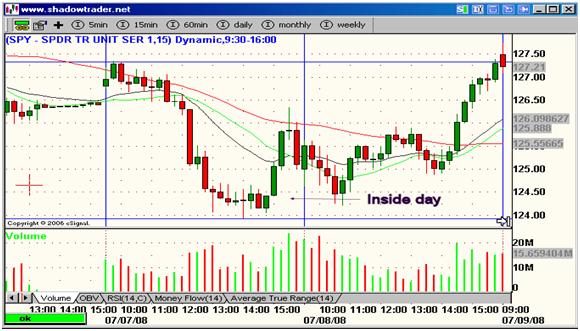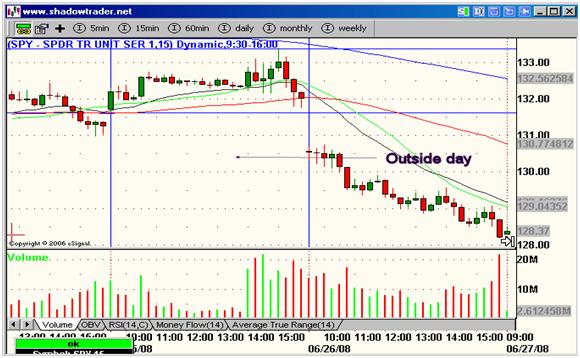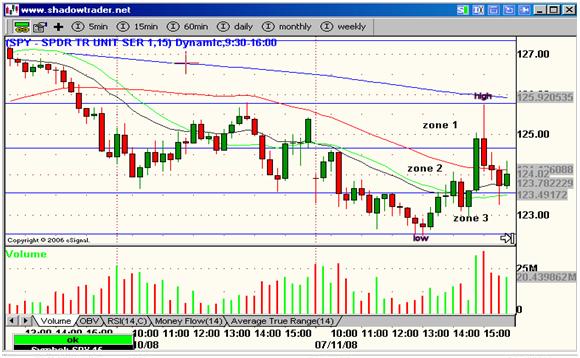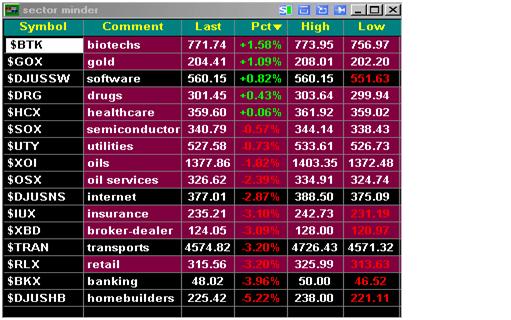10 Steps to Successful Day Trading, Part 1
1. Go “Top Down” for best results
Click here to learn how to utilize Bollinger Bands with a quantified, structured approach to increase your trading edges and secure greater gains with Trading with Bollinger Bands® – A Quantified Guide.
When looking for the best way to exploit intraday opportunities in the stock market, it’s always best to employ strategies that will allow you to have the wind at your back, so to speak. 85% of stocks follow the action in the broad market and as such you want to have the broad market moving in the same direction as your trades as often as possible. As timeframes get smaller from long term core holds to position trades to swing trades to day-trades, the direction of the broad market matters more and more on the outcome of your trade. Before entering any intraday position, discern the following:
– Is the market having an “inside” or “outside” day? An inside day is one in which the broad market is currently trading inside of the prior day’s range. An outside day is the opposite where the market has managed to either make a new two day high or a low and is trading outside of the prior day’s range. This matters a lot. Inside of the prior day’s range is usually a sign of a range bound market that is chopping around in fits and starts. This will generally frustrate the average day-trader because he/she will find excellent setups but they won’t seem to get moving. The trader will find that they will do better when the market has moved outside of the prior day’s range. Some day-traders have rules that they won’t trade at all if the market is not having an “outside day”. The snapshots of the SPY below illustrate what inside and outside days look like. In the first picture note that all of the action on 7/8 is within the range of the highs and lows of 7/7. In the second, all of the action of 6/26 is outside of the highs and lows of 6/25, thus creating the ‘outside day’.
– Where is the broad market in terms of its own support and resistance? This is a very key concept that many traders ignore because they are too focused on the pattern right in front of them of the individual stock they are trading. (More on that in Law #5). If for example you are trading from the long side you would want to know that in the next 15 – 30 minutes or whatever your timeframe is, the S&P is not going to run into any resistance on its longer term daily or weekly charts. The S&P 500 is your best bet for measuring broad market strength or weakness as it’s the benchmark index that all institutions measure the market by. If I know that there is a major resistance area at 1445 for instance in the SPX where the market has turned and dropped back before, then I am not going to be initiating any long day-trades if the S&P is for instance trading about 1442 or so and moving up. Remember that the index is just that, an index, meaning that it’s a collection of stocks. It hits its own support and resistance because the stocks that make up the index also have hit resistance or sold off. Even if your stock is what we call “in the clear”, i.e. has no notable resistance above it, if the broad market starts to sell off it will more than likely act as a drag on your long and you’ll end up swimming against the tide.
– Is the broad market currently going up or down? This one may seem obvious but you’d be surprised at how many people completely ignore it or misjudge the direction.
First, ignore what we call the Top Line figures. These are the amounts that the Dow, S&P, and Nasdaq are up or down on the day and are the figures that are most often quoted daily on CNBC, the radio, and in newspapers. The reason we say ignore them is because they are often very misleading.
The Dow could easily be quoted as being up 50 points and yet the trend is down all day. This is due to gaps. If the Dow gapped up that day and sold off directly from its open to fill the gap, then you will have a very hard time getting long day-trades to work that day at all because the intraday action of the broad market is actually down even though those top line figures are all green. In volatile times, these gaps can often be very large and spend the entire day filling by meandering towards the prior day’s close. In such a situation it’s imperative to be aware of the direction the market is actually moving rather than pay any attention to how much it’s “up” or “down”.
Secondly, be aware of where the broad market is in terms of the current day’s range. An easy way to do this is to divide the day’s action into three zones and label them 1, 2, 3 like in the picture below. Each zone is basically one third of the day’s range. When the market is in zone 2, which is the middle third of the days’ range, day-trades will often not work out very well because there is obviously equal pressure between bulls and bears. If the market is trading in zone 3, short trades will probably work better because sellers currently have the upper hand. In zone 1, long trades would be the way to go.
For the sake of illustration, this picture was taken at end of day. What you want to do is to start marking off the zones after approximately one hour of trade (10:30 am EST) has gone by. Obviously they will move over the course of the day if highs and lows change. No problem, just move your high and low lines up and down accordingly and redraw. The midday doldrums (usually 11:30 am to 1:30 pm EST) are a good time to regroup and redraw your zones before going into the afternoon session. In closing, keep the wind at your back by trading in the direction of the broad market at all times.
2. Use market internals to gauge the markets real strength and direction
It’s far beyond the scope of this article to do a complete discussion on the use of market internals. However, no set of rules on day-trading could ever be complete without a mention of them. They are the number one most important factor in predicting intraday market direction. I generally use Market Breadth (the amount of volume flowing in to up stocks minus the volume flowing into down stocks), the Advance Decline line (number of up ticking stocks minus the number of down ticking stocks), and the TRIN or Arms Index (essentially creating a fraction out of the breadth and advance decline lines and computing them into one figure), as my three main indicators of broad market bias. What I recommend for new traders to do is to put up charts of the three market internals right next to a chart of the SPY or $SPX. Make sure to have the internals set to the same timeframe as the broad market chart and just watch. How does the market constantly react or not react to changes in the three internals. Over time you will develop a feel for these movements and you will wonder how you ever traded without them.
3. Know your sectors
Whatever stock you are day-trading is part of some sector. If it’s KLAC for instance, then it belongs to a group that is known collectively as the $SOX or Philadelphia Semiconductor Index. If it’s ABX, then it’s part of $GOX or Amex Gold Miners Index., etc. Every stock out there is a part of some sub sector of the market. It’s imperative to know this when day-trading because you can use the relative strength in these sectors to give added momentum to your day-trades. You can start by keeping a list of about 15 – 20 sectors in a sector minder on your screen at all times. Have them sorted by their % change from the open so that you can see exactly how much they are up or down on just that day. An example is below:
Do research as to what stocks are in all of the different sectors. When looking for stocks to day-trade, simply looking at which sectors are extremely strong or weak (in comparison to the market) is a great place to start. If you are trading top down and you have discerned that the market is going up, then the sector that is holding the pole position in your sector list is probably going to have a lot of great opportunities for long day trades in it because it’s obvious that money is flowing to that sector. Reverse this situation when looking for shorts. Conversely, be aware that sectors are strong or weak because of institutional rotation. This is the “money flow” that we discussed above. The bottom line is that you don’t want to fight that, ever. There will always be stocks out there that are “outliers” which are not acting in sync with their respective sectors. So when you find that perfect bear flag pattern in BTU for instance, make sure that the $DJUSCL (coal sector that the stock is part of) is not one of the strongest sectors on the day.
Always note how just keeping the top down perspective when selecting sectors and stocks can keep you out of trouble. The number one reason that day-trades do not “follow through” is because at some step of the top down chain, something was out of sync. Either you bought in a weak market, or a weak sector or there was divergence in the internals that made you believe the market was stronger/weaker than it actually was. So to recap, knowing your sectors is just another way to stay top down and keep the wind at your back.
4. Relative Strength is the Key
Relative strength (or weakness for that matter) is simply a measure of how strong or weak a stock is against something else. Either measured against the broad market itself, or other stocks in its sector, or just other stocks in general. There are many ways to calculate this and there are lots of traders who make a great living trading only this style. I believe that in the spirit of the top down approach it can be of great help to you.
Usually you want to compare the performance of different issues and the broad market in terms of % change from open. This way you won’t get caught in the trap of thinking that stocks that have gapped up are stronger than they actually are. In a nutshell, look for issues that are outperforming the broad market by a good margin for longs and ones that are lagging the market for shorts. If the S&P is up 0.75% from the open and a stock you are interested in day-trading long has opened flat and is now up 0.25% then it’s probably not going to be much of a mover. Remember, stocks that are stronger than the market are exhibiting signs of institutional interest and thus they have greater momentum in the direction of their move and their counter – moves are usually shallower. A simple sector minder like the one above for the sectors can be set up if you trade a set universe of the same stocks every day. If not, then a simple scanner which can scan the whole market and find those issues that have the greatest % gains or losses on the day will point you in the right direction.
5. The Pattern is the Last Thing
By saying that the “pattern is the last thing”, I mean to draw attention to items 1 – 4 above and remind the trader that the above criteria need to be satisfied before searching for intraday patterns in individual stocks. You can find all the double bottoms, hammers, or bull flags in the world all day but if the market is not going to move in that direction, is range bound or the sector is weak, etc, the odds of your pattern following through are minimal. This is a key mistake that many day-traders make. They are unaware of what is happening in the bigger picture and simply believe that it’s a game of pattern recognition. When it all comes down to it, it is the synergy of many different patterns all working in sync that will create the playable move.
In the next article, Peter Reznicek concludes this series with more trading strategies to increase profitability and to help you start day-trading with more confidence, control, and aptitude. To read Part 2, click here
Peter Reznicek is the founder and head trader of both RBC Asset Management, a Philadelphia-based asset management firm, and ShadowTrader.net, an advisory firm, launched in 2005 that provides daily recommendations and analysis of equities and foreign exchange pairs. Mr. Reznicek also educates more than 16,000 ShadowTrader.net subscribers each weekend through his free Sunday presentation, the “ShadowTrader Video Weekly”, and also as editor of their flagship publication, the ShadowTraderPro Swing Trader. He has also hosted a popular call-in show on Philadelphia radio, and has had his commentary published on several popular financial websites.




